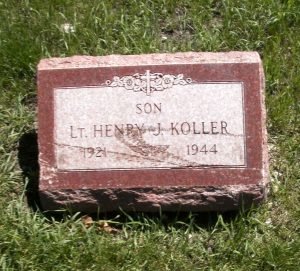2nd Lt. Henry J. Koller was born on April 6, 1921, in Oak Park, Illinois, to Henry C. Koller and Anna Schneider-Koller. He was known as “Bud” to his family. With his two sisters, he grew up first in Oak Park and Elmhurst, Illinois, and later at 1133 Elgin Avenue in Forest Park, Illinois. Henry attended Saint John Lutheran School, York High School in Elmhurst, and graduated from Proviso Township High School in Maywood, Illinois. After high school, he worked as a tool and die maker at the Crane Company in Chicago.
He registered for Selective service on February 16, 1942, and named his father as his contact person. He was inducted into the U.S. Army Air Corps on October 23, 1942, and sent to officer candidate school. His army serial number was O 783 196. He was trained at a number of bases and military schools. These included: Santa Ana Army Airfield, Santa Ana, California, Smyrna Army Airfield, Smyrna, Tennessee, Chicago, Illinois, Miami Army Airfield, Miami, Florida, Mount Pleasant, New York, Las Vegas, Army Airfield, Las Vegas, Nevada, Carlsbad Army Airfield, Carlsbad, Nevada, and finally Tonopah Army Airfield, Tonopah, Nevada. During his training, he qualified as a bombardier.
On September 8, 1944, during a nighttime high altitude bombing training mission, the B-24 Henry was a crew member on crashed. The army ruled that the cause of the crash was a result of the pilot and co-pilot not paying attention to the plane’s altitude while attempting to deal with a mechanical malfunction.
Caius Carpenter, who was the crew’s aerial gunner and the only survivor told the Central Nevada Museum and Historical Society what he remembered about the crash. According to him, Lt. Moss started up the plane but told engineering he was not going to fly the plane because of oil pressure problems. A second plane was assigned to the crew. The plane took off, but Lt. Moss returned to the field and landed because of low oil pressure. The crew was assigned a third plane to fly. Carpenter stated that as they boarded the plane, the co-pilot, Lt. Forest Carl said, “Since it’s our third plane, it should be the charm,” and he replied to Carl, “It probably will charm our asses..” Carpenter also said another crew member said, “This one will probably kill us.”
The bomber took off, on September 8, 1944, and crashed five miles from the airfield. According to Carpenter, shortly after takeoff, he heard a loud explosion and the plane shuttered. He lost his balance and was knocked out. When he awoke, he found himself pinned by wreckage. He saw debris and body parts all around him. Henry’s family was sent a telegram that he had died in a crash.
A casket with the Henry’s body was prepared for shipment to Chicago by the Ross-Burke Mortuary, Reno Nevada. By train, with a military escort, his casket was sent to the Zimmerman and Son Funeral Home, Forest Park, Illinois. On September 14, 1944, 2nd Lt. Henry Koller was buried at Oakridge Cemetery in Hillside, Illinois, in Section 10, Lot 251, Grave 1.








